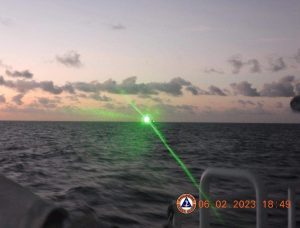The Philippines yesterday accused a Chinese coast guard ship of hitting a Philippine coast guard vessel with a military-grade laser during an encounter in a disputed part of the South China Sea.
The Philippine Coast Guard (PCG) said in a statement that the laser temporarily blinded some of the crew aboard the Philippine patrol vessel BRP Malapascua, and prevented it from approaching Second Thomas Shoal, a submerged reef inside the Philippines’ Exclusive Economic Zone (EEZ).
The Filipino vessel was en route to resupply a small contingent of troops stationed in the Sierra Madre, a rusted World War II-era warship that Manila grounded at Second Thomas Shoal in 1999 in order to reinforce its claim to the shoal.
The incident, which took place on February 6 but was only reported publicly yesterday, represented a “clear violation of Philippine sovereign rights,” the PCG stated. Aside from flashing the laser twice, it added, the Chinese ship also made “dangerous maneuvers” about 137 meters from the Filipino ship’s starboard side.”
“The deliberate blocking of the Philippine government ships to deliver food and supplies to our military personnel on board the BRP Sierra Madre is a blatant disregard for, and a clear violation of, Philippine sovereign rights in this part of the West Philippine Sea,” the coast guard said, using the name the Philippines has adopted for the stretch of waters close to its western coast.
The laser incident comes after the PCG reported in mid-January that a Filipino fishing boat had been forced by China’s coast guard to leave Second Thomas Shoal, which is known locally as Ayungin Shoal.
It is just the latest of hundreds of recent Chinese incursions into the waters of the Philippines’ EEZ, a 200-nautical-mile zone in which Manila enjoys exclusive right to resources under international law. Beijing claims a large section of the Philippines’ zone claims under its contentious “nine-dash line” maritime claim. According to The Associated Press, the Philippine government filed nearly 200 diplomatic protests against China’s actions in the disputed waters in 2022 alone.
However, this was reportedly the first time that it used lasers and caused physical suffering among Filipino personnel, a PCG spokesperson told the AP.
The Philippine military said that it was time for China to restrain its forces from committing “any provocative act that will endanger the lives of people.” A spokesperson for the Armed Forces of the Philippines told reporters that the Philippine defense chief deemed the Chinese coast guard’s action “offensive and unsafe.”
The laser attack took place a day after Reuters published an interview with the PCG chief, Admiral Artemio Abu, in which he said that the coast guard planned to deploy additional vessels and conduct more sorties and overflights of these areas in a bid to protect the nation’s maritime territory.
A Chinese foreign ministry spokesperson in Beijing said that a PCG vessel trespassed into Chinese waters without permission and that Chinese coast guard vessels responded “professionally and with restraint at the site in accordance with China’s law and international law.”
The alleged use of a laser suggests that the Chinese Coast Guard is innovating new ways of ratcheting up the pressure on the Philippines in disputed parts of the South China Sea, amid a strengthening of the Philippines’ security alliance with the United States. At the start of this month, the two sides agreed to expand the U.S. military’s access to Philippine military facilities under the 2014 Enhanced Defense Cooperation Agreement.
After a relatively quiet 2022 in the South China Sea, this incident suggests that the disputes are set once again to rise up the regional diplomatic agenda.

































